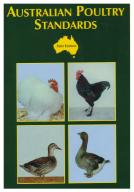Classification of breeds
The Australian Poultry Standard classifies all chicken breeds as either hard feather or soft feather, and then further divides them into the bantam or standard size. Breeds which have less under fluff and feathers which are closer to the body fall under hard feather, such as the Old English Game and Asil. Breeds with more under fluff and softer feathers, such as the Silkie, Australorp and Leghorn, are classed as soft feather.
The Australian Poultry Standards also includes standards for ducks, geese, turkeys and Guinea fowl. Ducks are divided into two classes, bantam or standard size, and all turkeys, geese and guinea fowl have only one class each.
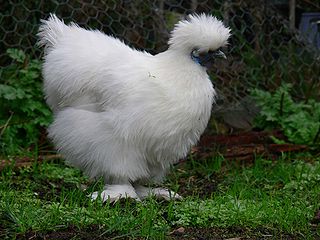
The Silkie is a breed of chicken named for its atypically fluffy plumage, which is said to feel like silk and satin. The breed has several other unusual qualities, such as black skin and bones, blue earlobes, and five toes on each foot, whereas most chickens have only four. They are often exhibited in poultry shows, and also appear in various colors. In addition to their distinctive physical characteristics, Silkies are well known for their calm and friendly temperament. It is among the most docile of poultry. Hens are also exceptionally broody, and care for young well. Although they are fair layers themselves, laying only about three eggs a week, they are commonly used to hatch eggs from other breeds and bird species due to their broody nature. Silkie chickens have been bred to have a wide variety of colors which include but are not limited to: Black, Blue, Buff, Partridge, Splash, White, Lavender, Paint and Porcelain.
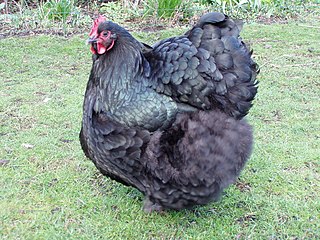
The Orpington is a British breed of chicken. It was bred in the late nineteenth century by William Cook of Orpington, Kent, in south-east England. It was intended to be a dual-purpose breed, to be reared both for eggs and for meat, but soon became exclusively a show bird.
Shamo (軍鶏) is an overall designation for gamefowl in Japan. There are seven recognised breeds of Shamo chicken in Japan, all of which are designated Natural Monuments of Japan. The Shamo breeds are thought to derive from fighting chickens of Malay type brought from Thailand in the early part of the 17th century.

The Australorp is a chicken breed of Australian origin, developed as a utility breed with a focus on egg laying and is famous for laying more than 300 eggs per year. It achieved world-wide popularity in the 1920s after the breed broke numerous world records for number of eggs laid and has been a popular breed in the western world since. It is one of eight poultry breeds created in Australia and recognised by the Australian Poultry Standards. The most popular colour of the breed is black, which is the only colour recognised in the United States of America, but blue and white are also recognised in Australia and the Poultry Club South Africa recognises buff, splash, wheaten laced and golden in addition.

The Japanese Bantam or Chabo is a Japanese breed of ornamental chicken. It is a true bantam breed, meaning that it has no large fowl counterpart. It characterised by very short legs and a large upright tail that reaches much higher than the head of the bird.
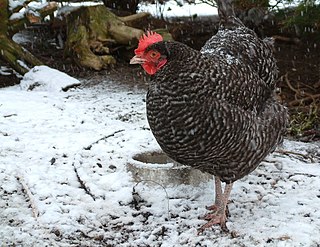
The Marans, French: Poule de Marans, is a French breed of dual-purpose chicken, reared both for meat and for its dark brown eggs. It originated in or near the port town of Marans, in the département of Charente-Maritime, in the Nouvelle-Aquitaine region of south-western France.

The Ancona is a breed of chicken which originated in the Marches, region of Italy, but which was bred to its present type mainly in the United Kingdom in the nineteenth century. It is named after the city of Ancona, capital of the Marche. It is popular in Britain and the United States, but uncommon in Italy; an initiative to re-establish it in its native area and preserve its biodiversity was launched in 2000. There are also Ancona bantams.
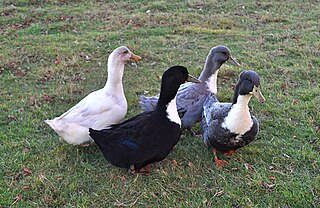
The Swedish Blue or Blue Swedish is a Swedish breed of domestic duck. It originated in the former dominion of Swedish Pomerania – now in north-west Poland and north-east Germany – and is documented there from 1835. It is closely similar to the Pomeranian Duck from the same general area, differing mainly in its white primary feathers.

The Call is a historic breed of small domestic duck. It is believed to have originated in the Netherlands, where the earliest descriptions and depictions of it date from the seventeenth century. It is similar in appearance to some other breeds of duck, but is much smaller, with a round head and very short bill. Ducks, but not drakes, are very loquacious and noisy, with a piercing high-pitched call which can be heard from far away.
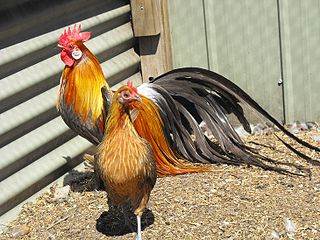
The Phoenix is a German breed of long-tailed chicken. It derives from cross-breeding of imported long-tailed Japanese birds similar to the Onagadori with other breeds.

The Barbu d'Uccle or Belgian d'Uccle, Dutch: Ukkelse Baardkriel, is a Belgian breed of bearded bantam chicken. It was first bred in the town of Uccle on the outskirts of Brussels, in central Belgium, in the early years of the twentieth century. It is a true bantam, with no standard-sized large fowl counterpart, and is one of eleven Belgian true bantam breeds.

The Sebright is a British breed of bantam chicken. It is a true bantam – a miniature bird with no corresponding large version – and is one of the oldest recorded British bantam breeds. It is named after Sir John Saunders Sebright, who created it as an ornamental breed by selective breeding in the early nineteenth century.
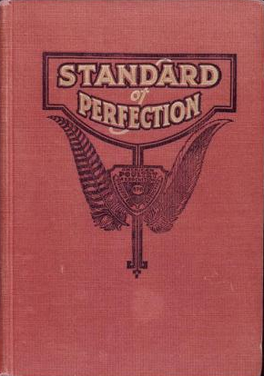
The American Standard of Perfection is the official breed standard for the poultry fancy in North America. First published in 1874 by the American Poultry Association, the Standard of Perfection classifies and describes the standard physical appearance, coloring and temperament for all recognized breeds of poultry, including chickens, ducks, turkeys, and geese. The current edition was published in 2015.

The American Bantam Association is a poultry fancy association for breeders of bantam poultry. It publishes the Bantam Standard, with detailed descriptions of all the bantam breeds and varieties that it recognizes; in most – but not all – cases, these are the same as those recognised by the American Poultry Association. It also publishes a quarterly magazine and annual yearbook, hosts poultry shows and provides judges for them, and provides information on bantam breeds.

The Australian Langshan is an Australian chicken breed, derived from the Croad Langshan and accepted by the Australian Poultry Standard as a recognized breed. The Australian Langshan is little known outside Australia but is a popular breed inside the country. The breed comes in both bantam and standard size.

The Pomeranian or Pommern duck is a breed of domesticated duck. It is a landrace originating in the German part of the baltic sea coast region called Pomerania. Pomeranian ducks share the same ancestors with other northern European duck breeds, such as the Shetland duck and Swedish Blue duck.

The Frizzle is a breed of chicken with characteristic curled or frizzled plumage. While the frizzle gene can be seen in many breeds, such as the Pekin and Polish, the Frizzle is recognised as a distinct breed in a number of European countries and Australia. In the United States frizzled chickens are not considered a breed, and at shows are judged by the standards of the breed they belong to.
The Australian Pit Game is a breed of chicken, developed in Australia in the early 1900s for cockfighting by British soldiers stationed in New South Wales.
